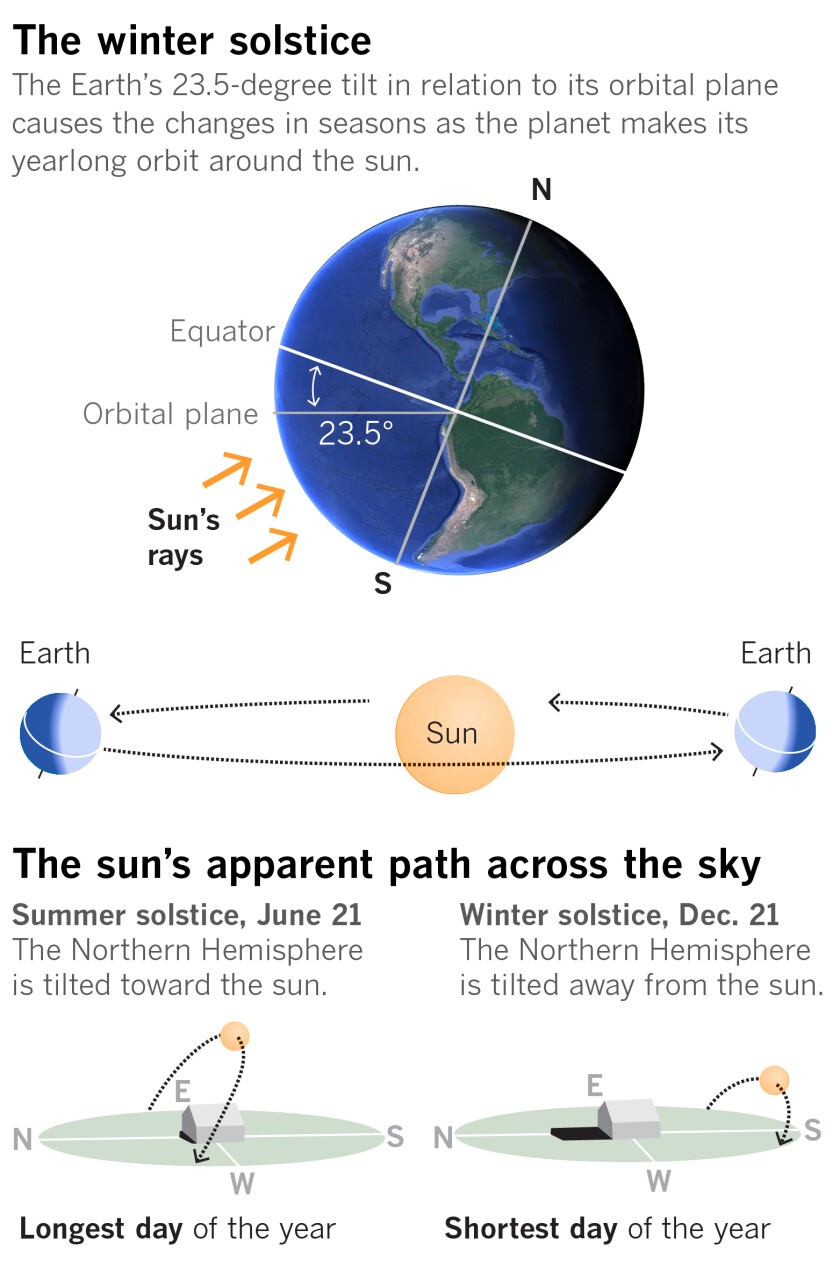What is the winter solstice?
HAPPY SOLSTICE EVERYONE
The December solstice in the Northern Hemisphere occurs when the North Pole reaches its maximum tilt away from the sun, causing the shortest period of daylight and the longest night of the year. In about six months, as Earth travels on its yearlong journey around the sun, the Northern Hemisphere will be tilted toward the sun, and the Southern Hemisphere will reach its maximum tilt away from the sun. The seasons are caused by the fact that Earth is tilted on its axis by 23.5 degrees.
The winter solstice is regarded as the beginning of winter, but from this point the days begin to lengthen. Still, the coldest part of the winter lags behind the solstice, usually coming in January and February. That’s because Earth is constantly losing heat, and more heat is leaving the reservoir in the Northern Hemisphere’s mid- and high latitudes than is being added to it. In the same way, the warmest days of the year lag behind the summer solstice, much as the hottest part of a summer day occurs several hours after the sun is at its noonday high point.


The December solstice happens at the same instant for everyone, everywhere on Earth – and December solstice 2019 arrives on December 22 at 04:19 UTC. That’s December 21 for much of North America. High summer for the Southern Hemisphere. For the Northern Hemisphere, the return of more sunlight!.
The winter solstice happens every year when the Sun reaches its most southerly declination of -23.5 degrees. In other words, it is when the North Pole is tilted farthest away from the Sun, delivering the fewest hours of sunlight of the year.
The Sun is directly overhead of the Tropic of Capricorn in the Southern Hemisphere during the December solstice and is closer to the horizon than at any other time in the year, meaning shorter days and longer nights.
The shortest day of the year lasts for 7 hours 49 minutes and 41 seconds in Britain, which is 8 hours, 49 minutes shorter than the June Solstice. As such, Thursday December 20th is the longest night of the year with the sun not rising until 08:03 GMT on Friday morning.
The day after the winter solstice marks the beginning of lengthening days, leading up to the summer solstice in June.
In the Southern Hemisphere, the opposite is true. Dawn comes early, and dusk comes late. The sun is high and the shortest noontime shadow of the year happens there. In the Southern Hemisphere, people will experience their longest day and shortest night.
Does the winter solstice always occur on December 21st?
While it more often than not falls on December 21st, the exact time of the solstice varies each year. In the Northern hemisphere the winter solstice is the shortest day of the year, because it is tilted away from the sun, and receives the least amount of sunlight on that day.
However, the earliest sunset does not occur on the solstice, because of the slight discrepancy between 'solar time' and the clocks we use.
The shortest day of the year often falls on December 21st, but the modern calendar of 365 days a year - with an extra day every four years - does not correspond exactly to the solar year of 365.2422 days.
The solstice can happen on December 20, 21, 22 or 23, though December 20 or 23 solstices are rare.
The last December 23 solstice was in 1903 and will not happen again until 2303.
What does 'solstice' mean?
The term 'solstice' derives from the Latin word 'solstitium', meaning 'Sun standing still'. On this day the Sun seems to stand still at the Tropic of Capricorn and then reverses its direction as it reaches its southernmost position as seen from the Earth.
Some prefer the more teutonic term 'sunturn' to descibe the event.
Is the solstice the first day of winter?
The answer might vary depending on who you ask. There are two types of winter: astronomical and meteorological.
Astronomical winter typically begins on December 21st, with the winter solstice, and ends on March 19th. Meteorological winter always begins on December 1st and ends on February 28th (February 29th during leap years).
While astronomical winters are determined by the Earth's orbit around the sun, meteorological winters are the three calendar months with the lowest average temperatures.
The Met Office tend to use the meteorological definition of the seasons.
Stonehenge and the solstice
Scores arrive at the prehistoric monument in Wiltshire to mark the occasion. Why is the site so important?
Stonehenge, the prehistoric monument located in Wiltshire, is carefully aligned on a sight-line that points to the winter solstice sunset (opposed to New Grange, which points to the winter solstice sunrise, and the Goseck circle, which is aligned to both the sunset and sunrise).
Archaeologists believe it was constructed from 3000 BC to 2000 BC and it is thought that the winter solstice was actually more important to the people who constructed Stonehenge than the Summer solstice.
The winter solstice was a time when cattle was slaughtered (so the animals would not have to be fed during the winter) and the majority of wine and beer was finally fermented.
The only other megalithic monuments in the British Isles which clearly align with the sun are Newgrange in County Meath, Ireland and Maeshowe situated on Mainland, Orkney, Scotland. Both famously face the winter solstice sunrise.
You can also see the solstice sunrise around the world; this website shows Winter solstice: Why pagans celebrate the shortest day of the year (a day late)



